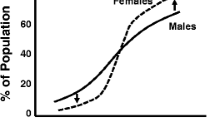Abstract
Blood pressure (BP) response to biofeedback-assisted relaxation is not uniform among hypertensive individuals. The purpose of this exploratory study was to determine if selected psychophysiological variables could be used to identify individuals able to lower blood pressure using biofeedback-assisted relaxation. Responders were defined using a preset criterion of 5 mm Hg or greater decrease in mean arterial pressure. A logistic regression model derived from five variables (heart rate, finger temperature, forehead muscle tension, plasma renin response to furosemide, and mean arterial pressure response to furosemide) provided significant predictive power for BP response, exhibiting a sensitivity of 84.6% and a specificity of 80.0%. With future validation, the proposed model may provide useful information to identify patients likely to benefit from biofeedback-assisted relaxation.
Similar content being viewed by others
References
Blanchard, E., Gordon, M., Wittrock, D., McCaffrey, R., & McCoy, G. (1991). A preliminary investigation of prediction of mean arterial pressure after self-regulatory treatments.Biofeedback and Self-Regulation, 16(2), 181–190.
Blanchard, E., McCoy, G., Berger, M., Musso, A., Pallmeyer, T., Gerardi, R., Gerardi, M., & Pangburn, L. (1989). A controlled comparison of thermal biofeedback and relaxation training in the treatment of essential hypertension. IV: Prediction of short-term clinical outcome.Behavior Therapy, 20, 405–415.
Blanchard, E., McCoy, G., Musso, A., Gerardi, M., Pallmeyer, T., Gerardi, R., Cotch, P., Siracusa, K., & Andrasik, F. (1986). A controlled comparison of thermal biofeedback and relaxation training in the treatment of essential hypertension: I. Short-term and long-term outcome.Behavior Therapy, 17, 563–579.
Cottier, C., Shapiro, K., & Julius, S. (1984) Treatment of mild hypertension with progressive muscle relaxation.Arch. Intern. Med., 144, 1954–1958.
Croog, S., Levine, S., Testa, M., Brown, B., Bulpitt, C., Jenkins, C., Klerman, G., & Williams, G. (1986). The effects of antihypertensive therapy on the quality of life.New England Journal of Medicine, 314, 1657–1664.
Department of Health and Human Services Public Health Service (1991).Healthy people 2000. National health promotion and disease prevention objectives (DHHS Publication No. PHS 91-50212). Washington, DC: U.S. Government Printing Office.
Fahrion S., Norris, P., Green, A., Green, E., & Snarr, C. (1986). Biobehavioral treatment of essential hypertension: A group outcome study.Biofeedback and Self-Regulation, 11(4), 257–279.
Glasgow, M., Engel, B., & D'Lugoff, B. (1984). A controlled study of a standardized behavioral stepped treatment for hypertension.Psychosomatic Medicine, 51, 10–26.
Glasgow, M., Gaarder, K., & Engel, B. (1982). Behavioral treatment of high blood pressure II. Acute and sustained effects of relaxation and systolic blood pressure biofeedback.Psychosomatic Medicine, 44, 155–239.
Harrell F. (1986). The logist procedure. In R. Hastings (Ed.)SUGI Supplemental Library, Version 5 (pp. 269–293), Cary, NC: SAS Innstitute.
Hosmer D., & Lemeshow, S. (1989).Applied logistic regression. New York: John Wiley & Sons.
Jacobsen, E. (1938).Progressive relaxation (Second Edition). Chicago: University of Chicago Press.
Luthe, W. (1969).Autogenic therapy. New York: Grune and Stratton.
Joint National Committee (1993). The fifth report of the joint national committee on detection, evaluation and treatment of high blood pressure.Archives of Internal Medicine, 155, 154–183.
Jöreskog, K., & Sörbom, D. (1988).Prelis: A preprocessor for lisrel. Mooresville, IN: Scientific Software.
Kaufmann, P., Jacob, R., Ewart, C., Chesney, M., Munez, L., Doub, N., & Mercer, W. (1988). Hypertension intervention pooling project.Health Psychology, 7, 222–224.
Laragh, J., Letcher, R., & Pickering, T. (1979). Renin profiling for diagnosis and treatment of hypertension.Journal of the American Medical Association, 241, 151–156.
McGrady, A., & Higgins, J. (1989). Prediction of response to biofeedback-assisted relaxation in hypertensives: Development of a hypertensive predictor profile (HYPP).Psychosomatic Medicine, 51, 277–284.
McGrady, A., Utz, S., Woerner, M., Bernal, G., & Higgins, J. (1986). Predictors of success in hypertensive treatment with biofeedback-assisted relaxation.Biofeedback and Self Regulation, 11(2), 95–103.
Patel, C., & North, W. (1975). Randomized controlled trial of yoga and biofeedback in management of hypertension.Lancet, 2, 93–95.
SAS Institute Inc. (1989).Sas/stat user's guide, Version 6, fourth edition, (Vol. 2). Cary, NC: SAS Institute Inc.
Shapiro, D., & Goldstein, I. (1982). Biobehavioral perspectives on hypertension.Journal of Consulting and Clinical Psychology, 50, 841–858.
Spielberger, C., Gorsuch, R., & Lushene, R. (1970).STAI manual for the state-trait anxiety inventory. Palo Alto: Consulting Psychologists Press.
Author information
Authors and Affiliations
Rights and permissions
About this article
Cite this article
Weaver, M.T., McGrady, A. A provisional model to predict blood pressure response to biofeedback-assisted relaxation. Biofeedback and Self-Regulation 20, 229–240 (1995). https://doi.org/10.1007/BF01474515
Issue Date:
DOI: https://doi.org/10.1007/BF01474515




